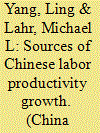| Srl | Item |
| 1 |
ID:
166921


|
|
|
|
|
| Summary/Abstract |
This paper adopts data envelopment analysis, namely the range adjusted measure (RAM) which is based on the additive structure, to measure the technical efficiency and productivity change. Note that we distinguish among energy and non-energy inputs in the analysis. The Luenberger productivity indicator is decomposed for the provinces of China for the period of 2006–2015. Specifically, we seek to identify the key directions for energy conservation and emission reduction by analyzing the environmental productivity change decomposition. The results show that sulfur dioxide and carbon dioxide emissions from primary energy consumption along with primary energy consumption are important variables contributing to atmospheric environmental inefficiency in Chinese provinces. Furthermore, static efficiency scores associated with energy consumption and atmospheric emission (sulfur dioxide, nitrogen oxides and carbon dioxide emissions) are lower for Hebei, Shandong, Henan and Shanxi in North China, whereas Beijing, Tianjin, Shanghai, Guangdong and Fujian show higher values of this kind of efficiency. Atmospheric emissions contribute to the growth in the atmospheric environmental productivity to a higher extent if compared to energy consumption. Therefore, Chinese energy policy should address the environmental regulation of energy consumption.
|
|
|
|
|
|
|
|
|
|
|
|
|
|
|
|
| 2 |
ID:
101157


|
|
|
|
|
| Publication |
2010.
|
| Summary/Abstract |
We decompose labor productivity growth from 1987 to 2005 by examining six partial factors (both supply and demand): changes in value-added coefficients, labor inputs, shares of sectoral demands that are fulfilled domestically, input mix, and the intra-sectoral shares and intersectoral mix of final demand. Our analysis confirms that simply by virtue of its size and extremely low level of labor productivity, China's farm sector continues to weigh heavily in China's overall economic advances. Labor savings have levied the largest influence on the labor productivity on all sectors across all three study subperiods. We find that this transition is highly correlated with capital deepening that accompanies China's opening up process. Still, changes in the intra-sectoral shares and the intersectoral mix of China's final demand also have become quite strong, especially in recent periods. Due to ever-increasing competitive pressures as China continues to open, changes in industries value-added coefficients have tended to counteract some of the positive benefits of labor savings for most sectors. The effects on changes in labor productivity of technology change and changes in the use of imports have been comparatively negligible and any variation in their sectoral effects have been waning over time.
|
|
|
|
|
|
|
|
|
|
|
|
|
|
|
|